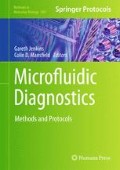Abstract
The capping of microfluidic features fabricated in glass substrates is achievable by various technological methods. Of the entire spectrum of possibilities (gluing, glass bonding via intermediate layers, pressure or plasma-assisted glass bonding, etc.) a detailed description of three techniques is presented here. The first is a low temperature PDMS-glass adhesion bonding, the second is medium temperature pressure assisted glass–glass bonding, and finally, high temperature glass–glass fusion bonding. All these protocols allow completion of the manufacturing process for a fully enclosed microfluidic chip. Nevertheless, as they are complementary rather than competing methods, they effectively extend the range of tools available to fabricate lab-on-a-chip microdevices. Each has its own merits and each could feasibly be used at different developmental stages of a given microfluidic device.
Access this chapter
Tax calculation will be finalised at checkout
Purchases are for personal use only
References
Plecis A, Chen Y (2008) Improved glass–PDMS–glass device technology for accurate measurements of electro-osmotic mobilities. Microelectron Eng 85:1334–1336
Chang JK, Bang H, Park S-J et al (2003) Fabrication of the PDMS microchip for serially diluting sample with buffer. Microsyst Technol 9:555–558
Oh KW, Han A, Bhansali S et al (2002) A low-temperature bonding technique using spin-on fluorocarbon polymers to assemble microsystems. J Micromech Microeng 12:187–191
Zhou X, Poenar DP, Liu KY et al (2007) Glass-based BioMEMS devices for optically excited cell impedance measurement. Sensor Actuat A 133:301–310
Wilke R, Büttgenbach S (2003) A micromachined capillary electrophoresis chip with fully integrated electrodes for separation and electrochemical detection. Biosens Bioelectron 19:149–153
Mazurczyk R, Vieillard J, Bouchard A, Hannes B, Krawczyk S (2006) A novel concept of the integrated fluorescence detection system and its application in a lab-on-a-chip microdevice. Sensor Actuat B 118:11–19
Vieillard J, Mazurczyk R, Morin C, Hannes B, Chevolot Y, Desbène P-L, Krawczyk S (2007) Application of microfluidic chip with integrated optics for electrophoretic separations of proteins. J Chromatogr B 845:218–225
Chiem N, Lockyear-Shultz L, Andersson P et al (2000) Room temperature bonding of micromachined glass devices for capillary electrophoresis. Sensor Actuat B 63:147–152
Jia Z-J, Fang Q, Fang Z-L (2004) Bonding of glass microfluidic chips at room temperatures. Anal Chem 76:5597–5602
Bhattacharya S, Gao Y, Korampally V et al (2007) Mechanics of plasma exposed spin-on-glass (SOG) and polydimethyl siloxane (PDMS) surfaces and their impact on bond strength. Appl Surf Sci 253:4220–4225
Zhang M, Zhao J, Gao L (2008) Glass wafers bonding via Diels-Alder reaction at mild temperature. Sensor Actuat A 141:213–216
Sayah A, Solignac D, Cueni T et al (2000) Development of novel low temperature bonding technologies for microchip chemical analysis applications. Sensor Actuat 84:103–108
Iles A, Oki A, Pamme N (2007) Bonding of soda-lime glass microchips at low temperature. Microfluid Nanofluid 3:119–122
Stjernström M, Roeraade J (1998) Method for fabrication of microfluidic systems in glass. J Micromech Microeng 8:33–38
Fu L-M, Yang R-J, Lee G-B (2003) Electrokinetic focusing injection methods on microfluidic devices. Anal Chem 75:1905–1910
Mao P, Han J (2005) Fabrication and characterisation of 20 nm planar nanofluidic channels by glass–glass and glass–silicon bonding. Lab Chip 5:837–844
Plöbl A, Kräuter G (1999) Wafer direct bonding: tailoring adhesion between brittle materials. Mater Sci Eng R25:1–88
Vallin Ö, Jonsson K, Lindberg U (2005) Adhesion quantification methods for wafer bonding. Mater Sci Eng R 50:109–165
Holden M, Kumar S, Castellana E et al (2003) Generating fixed concentration arrays in a microfluidic device. Sensor Actuat B 92:199–207
Gueguen P, Ventosa C, Di Cioccio L et al (2010) Physics of direct bonding: applications to 3D heterogeneous or monolithic integration. Microelectron Eng 87:477–484
Author information
Authors and Affiliations
Corresponding author
Editor information
Editors and Affiliations
Rights and permissions
Copyright information
© 2013 Springer Science+Business Media,LLC
About this protocol
Cite this protocol
Mazurczyk, R., Mansfield, C.D., Lygan, M. (2013). Glass Microstructure Capping and Bonding Techniques. In: Jenkins, G., Mansfield, C. (eds) Microfluidic Diagnostics. Methods in Molecular Biology, vol 949. Humana Press, Totowa, NJ. https://doi.org/10.1007/978-1-62703-134-9_10
Download citation
DOI: https://doi.org/10.1007/978-1-62703-134-9_10
Published:
Publisher Name: Humana Press, Totowa, NJ
Print ISBN: 978-1-62703-133-2
Online ISBN: 978-1-62703-134-9
eBook Packages: Springer Protocols

